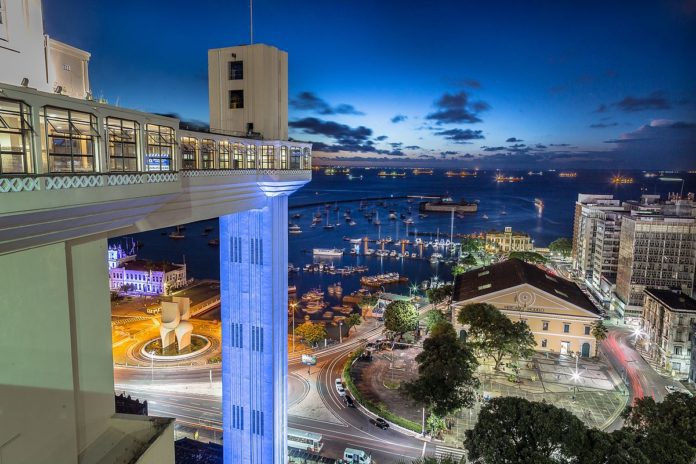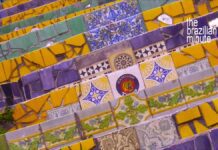
April is ‘Discovery Month’ at Connect Brazil.
Exploring the Mercado Modelo in Salvador, Bahia is unlike any other experience.
Salvador, Bahia is renowned as the nexus of Brazilian culture and for its close connections to Mother Africa. Truth is, there is nowhere else in the Americas where the purest traditions of Africa are woven into the fabric of daily life.
April is Discovery Month here at Connect Brazil. History shows April 22, 1500, when Portuguese explorer Pedro Alvarez Cabral landed at Porto Seguro, 250 miles south of Salvador.
We’ll put this month to good use with plenty of tips, facts, and fun as we get to know a little more about Brazil. Let’s begin with one of Salvador’s favorite spots.
Exploring Salvador, Bahia’s Mercado Modelo
The Mercado Modelo is a not-to-be-missed market for Brazilian art, crafts, and handmade goods. It is one of Salvador’s Bahia’s best-known landmarks. You’ll find the market building set on its own near the old harbor. This market is across from the Elevador Lacerda, which connects the old and new parts of the city of Salvador.
The site dates to 1861 when a large building was opened as a Customs Office for imports arriving from Salvador’s international port.
Then, in 1971 the building was converted into the present-day Mercado and completely rebuilt in 1984 after a fire.
Approaching The Experience
Join a guided tour, take the Lacerda Elevator to Salvador’s lower level, or hail a cab from your Hotel to arrive. Either way, exploring Salvador’s Mercado Modelo is easy to reach and its simple but impressive structure is sure to capture your imagination.
Outside, you will see large, wafting stands filled with thousands of colorful ribbons. These small ribbons are called the Ribbons of Bonfim. Be sure to have it tied with three knots. Each one represents a wish and good fortune. And you’ll need to wear it until the ribbon falls off on its own.
As you approach the entrance, you’ll no doubt become immersed in Salvador’s cultural connection to its African roots.
A crowded maze of more than 250 shops, stalls, and kiosks await your arrival.
Browse through original artwork, handmade jewelry, and religious artifacts. Stop by street food vendors to sample Bahia’s centuries-old culinary traditions. Bahian lace is always a treasured find, as is Brazilian clothing, including Capoeira pants and headdresses.
You’ll even come across intricate wood carvings along with musical and percussion instruments. And yes, you’ll want to load up on t-shirts, trinkets, and souvenirs for friends and family back home.
The Ancient Art of Haggling
Prices throughout Salvador Bahia’s Mercado Modelo are close to what you will pay merchants in the Pelourinho district. You can pay the posted price or you enjoy the Old World tradition of the Haggel.
Barter, negociate, or haggle? Call it what you will. Just remember that a good deal is struck when both parties are satisfied. It’s the art of the deal!
As a point of fact, if you don’t haggle you are sure to end up paying much more for those cherished items and must-have souvenirs.
Never will this be more true that when purchasing jewelry, Cachaca rum, and handcrafted items. As for original artwork, use your discretion. Artists devote much time and creativity goes into these items and as such, they carry intrinsic value.
And, of course, if you see ‘Made In China’, take a pass.
Deciphering The Gods
Some of the nicest presentations are the painted statues of candomblé deities. Look for the sign “antigos religiosos” – but use caution. And ask good questions.
These statuettes and items may seem like souvenirs. However, keep in mind that a large percentage of Brazilian believe in the mystical powers of the gods they represent.
For these, each deity portrays both a good and evil side to their personality. We invite you to learn more about these Orixas.
We recommend Iemanja, the goddess of the sea as a safe place to start. And by all means stay away from Exú, the trickster.
In the square in front of the market, you’ll find more arts and crafts stalls with a host of hippie-fair items and occasional capoeira demonstrations and live music.
Know Before You Go
Even if you are only window-shopping, exploring Salvador Bahia’s Mercado Modelo is an enjoyable time well-spent. The market plaza and its environs are always culturally active, drawing crowds of visiting tourists and locals, too.
That said, it’s always a good idea to be aware of what’s going on around you. Just like Portland, New York, Chicago, or San Fransico, the Mercado Model is frequented by pick-pockets, too. And it is best to visit during the daytime.
If you did not convert your currency to Brazilian Reis at your Hotel or Cambio exchange, you will see ATM machines nearby. An information office is found near the front entrance, while upstairs is a good place to enjoy an ice-cold beer and a snack.
Salvador’s Mercado Model is open Monday to Saturday, 9 am-7 pm, and Sundays, 9 am-2 pm.
Exploring Salvador Bahia’s Mercado Modelo
Music, travel, friends, and fun!
Stories like ‘Exploring Salvador Bahia’s Mercado Modelo’ are what we do. Why don’t you join us?
Sign Up for our e-letter. Listen to our ‘always live’ streaming station and our 15 streaming music channels, always free. Browse our Lifestyle Directory. Click here to like our Facebook page and here for Brazilian events coast to coast.








